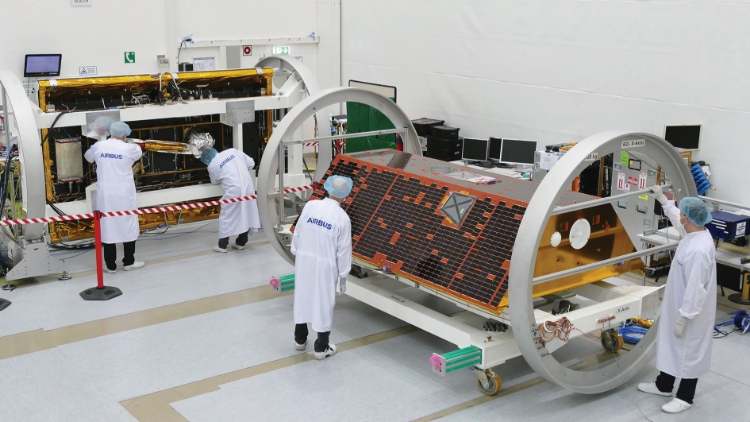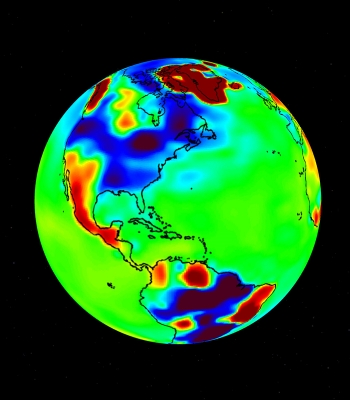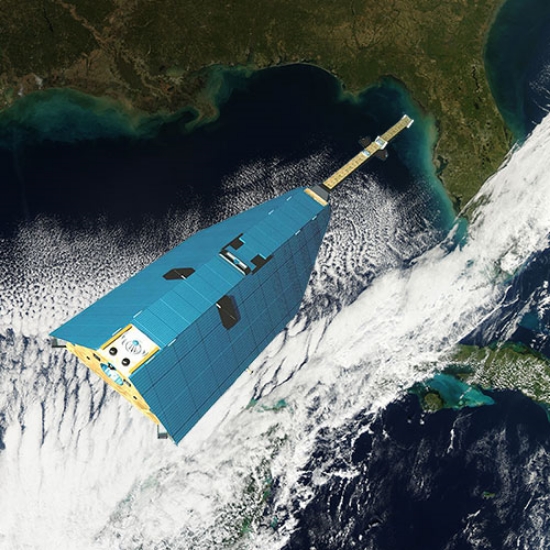All matter in the Earth system has mass and exerts a gravitational pull, including a pull on orbiting Earth satellites. By precisely measuring changes in Earth's gravity field with regional resolution from month to month, the Gravity Recovery and Climate Experiment Follow-On (GRACE-FO) mission continues the GRACE mission’s critical task of measuring and monitoring the movements of mass within and between Earth’s atmosphere, oceans, land and ice sheets, as well as within Earth itself (such as from large earthquakes and slow changes in Earth’s viscous mantle). These data provide unique insights into Earth’s changing climate, Earth system processes and even the impacts of some human activities. They also have far-reaching benefits to society, such as improving the accuracy of environmental monitoring and forecasts.
GRACE-FO, a partnership between NASA and the German Research Centre for Geosciences (GeoForschungsZentrum, GFZ), extends the 15-plus-year data record of GRACE, which operated from 2002 to 2017, and will demonstrate new technology to potentially improve upon the precision of GRACE’s measurements for future GRACE-like missions. The importance of continuing measurements of mass change was recently highlighted by the National Academy of Sciences in its 2017-2027 Decadal Survey for Earth Science and Applications from Space, released in December 2017. The survey identified measurements of mass change as one of NASA’s five highest-priority Earth observation needs for the next decade and as a foundational element to ensure continuity with both GRACE and GRACE-FO.
Having a time series of measurements of sufficient length, consistency and continuity is vital to determining climate variability and change. Whether or not observed multiyear trends represent long-term changes in mass balance can only be determined by extending the length of the observations. By continuing the essential climate data record established by GRACE, GRACE-FO will provide invaluable observations of long-term climate-related mass changes, such as the ongoing loss of mass of the West Antarctic and Greenland ice sheets, and many other land glaciers, as well as changes in the water cycle and land water storage. Longer records allow climate scientists to separate short-term variability from longer-term trends.
Conceptually nearly identical to the GRACE mission, GRACE-FO consists of two identical satellites flying in formation around Earth at an initial altitude of approximately 305 miles (490 kilometers) and a nominal separation distance of 137 miles (220 kilometers). Instruments on board the satellites precisely measure changes in the distance between them due to orbital perturbations caused by variations in Earth’s gravity field over space and time. By combining these data with precise knowledge of the satellites’ positions as determined by GPS observations, position and orientation of the satellites as measured by star trackers, and non-gravitational forces acting on each satellite as measured by high-precision accelerometers, the distribution of Earth’s mass changes near the surface will be calculated every month and tracked over time.
GRACE-FO will expand GRACE’s legacy of scientific achievements. These include tracking mass changes in Earth’s polar ice sheets and mountain glaciers (which impact global sea level); estimating total water storage on land (from groundwater changes in deep aquifers to changes in soil moisture and surface water); inferring changes in deep ocean currents, a driving force in climate; and even measuring changes within the solid Earth itself, such as postglacial rebound and the impact of major earthquakes. To date, GRACE observations have been used in more than 4,300 research publications.
GRACE-FO’s primary mission objective is to continue the high-resolution monthly global maps of Earth's gravity field and surface mass changes of the original GRACE mission over a period of five years. The secondary objectives are twofold: first, GRACE-FO will demonstrate the effectiveness of a novel Laser Ranging Interferometer (LRI) in improving satellite-to-satellite tracking measurement performance, laying the groundwork for improved GRACE-like geodetic missions in the future. The LRI will be the first-ever demonstration of laser interferometry in space between satellites. Second, GRACE-FO will measure the structure of Earth’s atmosphere by performing radio occultation measurements of GPS tracking signals, a cost-effective technique to measure vertical atmospheric temperature and humidity profiles by observing how much signals from GPS satellites are distorted as they travel through the atmosphere. The sounding process will provide 200 to 250 vital profiles of atmospheric temperature and water vapor content per satellite each day to aid weather forecasting. GPS Radio Occultation (GPSRO) data from GRACE were provided to U.S. and European weather prediction centers for use in weather forecasting products.
As on GRACE, NASA is partnering with Germany on GRACE-FO to provide continuity with the GRACE measurements. While for continuity the baseline science and performance requirements are the same, the GRACE-FO mission implements improvements based on lessons learned from GRACE. Design changes were limited to those that were required to meet the recommendations of the GRACE Science Study Team, to use the current-generation satellite bus, to resolve hardware obsolescence issues and to accommodate the Laser Ranging Interferometer as a technology demonstration.



